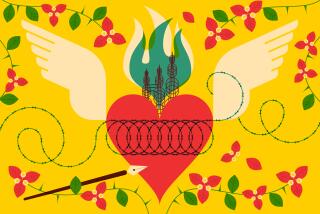Argentian star Samanta Schweblin’s destabilizing English debut, ‘Fever Dream’
Over the last two decades, Argentina’s rural communities have reported skyrocketing rates of birth abnormalities, miscarriages and cancer. In the same period, genetically modified soy has blanketed the region, helped along by copious pesticides. GM soy arrived in Argentina in 1996 and accounted for 23% of the country’s exports in 2014. Even as rural families suffer, planes fly over the pampas, spraying chemicals on the vibrant green monoculture that ripples all the way to the horizon.
This is the landscape in which Samanta Schweblin’s unsettling debut novel unfolds, to a soundtrack of rustling soy fields. “Fever Dream” is a narrative nesting doll best illustrated by one early scene: Carla, a country woman in a gold bikini, sits in a car parked in a driveway, telling a terrifying story about the day she turned her back and her son, David, drank from a poisoned creek. She’s talking to Amanda, a well-to-do woman from Buenos Aires vacationing in the countryside with her daughter.
Carla’s story is nestled in the story of Amanda’s vacation, and wrapped around that is another story still: “Fever Dream” and all its events are framed as a conversation between Amanda and Carla’s son David — characters who meet in the flesh only once. They’re speaking in the local emergency clinic, but they’re also in some dark no-man’s-land, a liminal dimension: “There’s only darkness, and you’re talking into my ear. I don’t even know if this is really happening,” Amanda says. David is pushing Amanda to pinpoint the moment something terrible happened, which she will know from a feeling of worms in her body:
“It’s dark and I can’t see,” she says. “The sheets are rough, they bunch up under my body. I can’t move, but I’m talking.”
“It’s the worms,” David replies, his voice always italicized. “You have to be patient and wait. And while we wait, we have to find the exact moment when the worms come into being.”
Where are they really? What has happened, and what do the worms signify? Why is David pushing Amanda to tell him this story? These are “Fever Dream’s” questions.
Though this is a debut novel, Buenos Aires-born Schweblin is already a luminary of Argentine fiction, with three award-winning short-story collections under her belt, not to mention anointment in 2010 as one of Granta’s best Spanish-language writers. In fact, “luminary of Argentine fiction” might be too restrictive: today, Schweblin lives in Berlin, and her work has been translated into 20 languages. With this first book-length translation into English, she has the backing of an illustrious publisher and a gifted translator, Megan McDowell, who’s worked with several rising stars of Latin American fiction. “Fever Dream” should position Schweblin comfortably alongside young American writers such as Amelia Gray and Jesse Ball.
Like these American counterparts, Schweblin writes in a spare and highly impressionistic style that embraces instability: of space, identity, and the reader’s trust. But though it taps into an international mood, “Fever Dream” is also a deeply Argentine work, about parental love, rapacious industrial agriculture and the trauma of history. In fact, the novel represents a perfect marriage of form and subject, in which its narrative instability — which is so of the literary moment — viscerally recreates the insecurities of life in the Argentine countryside today.
Schweblin, like Gray and Ball, has found ways to electrify and destabilize the physical world. In particular, she shatters the notion that there might be such a thing as a safe space. The title of the Spanish edition translates to “Rescue Distance,” a recurring phrase describing the distance from which Amanda can safely rescue her daughter. “I spend half the day calculating it,” she says, because “sooner or later something terrible will happen” — a clenched conviction other parents might well recognize.
But there’s no such thing as “rescue distance” when the earth and the water are saturated with toxic chemicals. Schweblin sets up the quaint notion in order to knock it down: Nowhere is safe, and there will be no rescuing. This is a defining characteristic of postmodern horror stories, but it’s also precisely the experience of living in a landscape that’s been poisoned.
Identity, too, is destabilized in a profoundly Argentine way. David’s voice ghoulishly frames the novel, but David also appears as an embodied and deeply uncanny character. The poisoning and its only cure have split the boy from his soul. And this in a country where 35 years ago, parents were being kidnapped, tortured, and disappeared, their babies stolen and brought up by the families of the military dictatorship. Just like this novel, Argentina is haunted by ghost children with split identities.
“Fever Dream,” then, is a novel about childless parents and parentless children, about split identities and living on land you can’t trust — which is to say, it’s a novel about Argentina’s struggles. More than that, it’s the scariest of all things: a ghost story that is, in essence, true.
Robins is a writer and translator who lives in Los Angeles.
Samanta Schweblin, translated by Megan McDowell
Riverhead: 192 pp., $25
More to Read
Sign up for our Book Club newsletter
Get the latest news, events and more from the Los Angeles Times Book Club, and help us get L.A. reading and talking.
You may occasionally receive promotional content from the Los Angeles Times.






